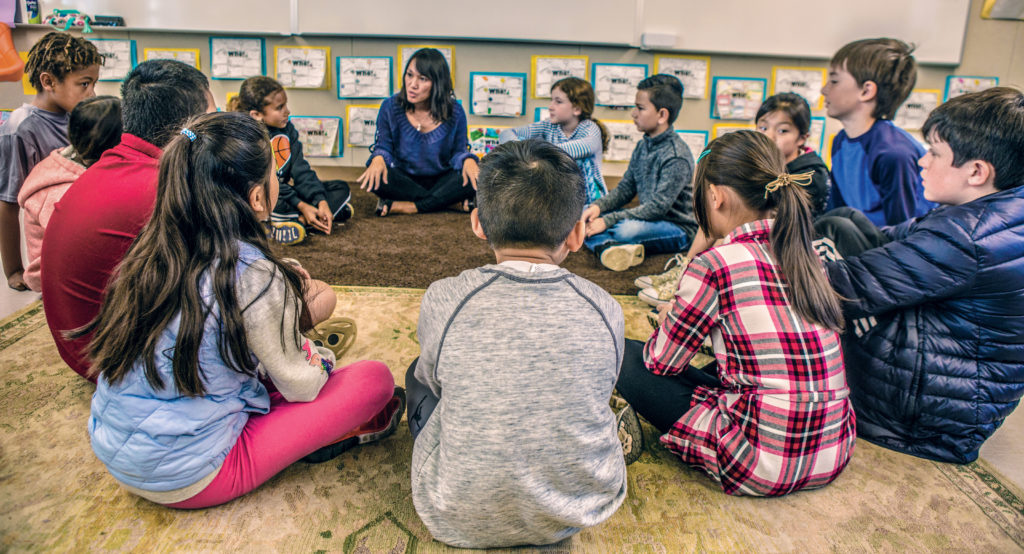Last May, I sat through yet another professional learning day for intruder training. We spent hours preparing for the worst. I left the training saying to myself, “I get why this is important, but why are we not spending time on prevention for our students?” Meanwhile, I kept seeing a lot of buzz on social media for Collaborative Classroom’s Caring School Community program and their work around social and emotional learning. I thought this might be the prevention piece schools need! So, I gave it a try.
As a sixth-grade teacher, one of my strengths is building strong relationships with kids, but what about strong relationships among the middle school students? Sure, I had groups of kids who knew each other from organized sports or from one of the four elementary buildings that fed into the middle school where I teach, but a sense of student camaraderie and connectedness still seemed to be missing. This idea of strengthening the classroom community was what drew me to the Caring School Community program.

We started the year by articulating our school and classroom rules and norms about how the students wanted to treat one another. Advisory lessons provided opportunities for students to share their thinking about what it means to adhere to the rules that we created and what a community that adheres to those rules would look like. Each Caring School Community lesson starts with a greeting, ensuring that each student is welcomed, followed by a “getting to know you” activity. In the past, I have started my school year off with “getting to know you” activities, but once we started diving into the curriculum, those activities dropped off. With the Caring School Community program, “getting to know you” activities are woven in throughout each week to ensure that student relationships continue to develop and strengthen.
After the rules and norms were established, we spent time explicitly learning about organization, which was a huge benefit to many of the students. About these lessons, one student even shared with me, “It has changed how I manage my time because I used to do work late but that has changed.”
In the middle school grades, Caring School Community lessons take place during Advisory. They look at ways to extend the norms of our behavior to other aspects of the school community, such as the lunchroom, hallways, and bus rides to and from school. These activities and lessons provide a natural way for the teacher to build relationships with the students and for them to build relationships with one another. One student shared, “My favorite thing about Advisory time was how I got to know my classmates and my teacher better.” Another student shared that their favorite part of Advisory is that “nobody is judging you.” Yet another said about Advisory that it provides a time to “interact with people that we would usually not hang out with.”
During Advisory, we discussed the challenges that following our norms present in different situations. Through these lessons, we determined how best to take responsibility for our actions, how to resolve situations that didn’t quite go the way we wanted them to in all areas of the school community, and how to better understand one another’s points of view. One student shared, “My favorite lesson was learning about empathy. It really made me see things from another person’s point of view.” (I hadn’t realized what an impact the lessons about putting yourself in someone else’s shoes had on them.) Another student shared with me, “I always think that middle school can be stressful, and because of Advisory I know that a lot of people feel the same way.” Through the discussions that the Caring School Community lessons generated, she was able to discover that she and her classmates shared a lot of the same worries and concerns.
Recently, I surveyed my students and asked, How have you changed as a result of the Caring School Community lessons experienced in Advisory? Here is a sampling of the responses:
- “I have been more understanding of my friends.”
- “I think about other people’s lives.”
- “I put myself in other people’s shoes and see what they are going through.”
- “The empathy lessons made me see things from other people’s points of view—this includes outside of school as well.”
- “I have learned never to judge people without getting to know them first.”
- “I feel like a nicer person.”
- “I have been a better person and really thought about how words might hurt people.”
Across the year, students develop empathy with and get to know one another. Advisory time sets the tone for the day and is a great way to build community within our classrooms. It truly is my favorite part of the day!
